

|
All Photographs © Sam Oppenheim
|
|||||||||||||
| ||||||||||||||
| |||||||||||||||||
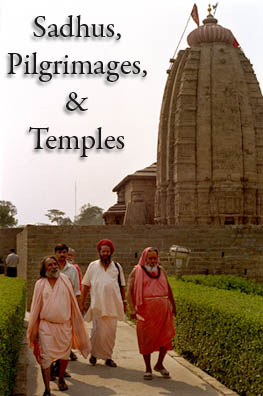
By Sam Oppenheim 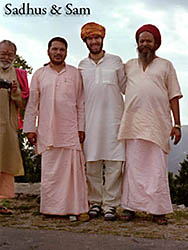 The past month has once again proven to be an exploration of Indian Geography, Spirituality, and Personality. My recent adventures began with my departure from MUSSOORIE, and farewells to my good friends there. I descended from the relatively cool sunny hilltop at 2,500 meters to the sweltering heat of the Indian plains.
The past month has once again proven to be an exploration of Indian Geography, Spirituality, and Personality. My recent adventures began with my departure from MUSSOORIE, and farewells to my good friends there. I descended from the relatively cool sunny hilltop at 2,500 meters to the sweltering heat of the Indian plains.Most of the subcontinent from April though June gets baked in a hot and humid oven of pollution, with daytime peak temperatures over 110 degrees. This weather culminates in the Monsoon from June though August. The Himalayan foothills and mountains, however, provide cool fresh air and respite from the plains. Therefore they are the summer resorts for the well-to-do, and a century ago the British moved their capitol to the hills every summer to rule the continent with comfort. In Delhi I sweat constantly. Even after sunset the "Loo" or hot humid winds continue to blow. The air stays swollen with heat, moisture, and pollution 24 hours a day unlike the desert, which cools off each night. The reason I left the hills was to meet Babaji, a sadhu, and his retinue of sadhus at the Nizamuddin Rail Station in New Delhi. I first met Tapasvi Baba Kalyandasji, or Babaji for short, at the Maha Kumbha Mela last year, and saw him two months previous in Almora after my foot got run over (Travelogue 8). 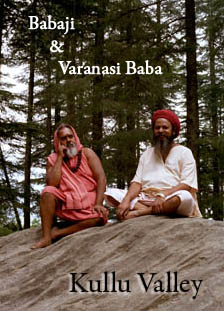
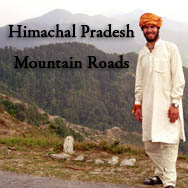
He invited me to meet him here for an adventure traveling with Sadhus, ostensibly for spiritual tourism, in Himachal Pradesh. This state borders China (Tibet), Kashmir, Uttaranchal (where Mussoorie and Gangotri are) and the desert Punjab regions. The state thus offers a variety of Punjabi areas, Tibetan regions like Dharamshala, foothills, beautiful river valleys, and snowcapped mountains as well. All the rivers of Himachal Pradesh drain into the "Punjab" - five rivers - which are tributaries of the Great Indus River, mostly flowing through Pakistan. Therefore, all our travel was on twisty mountain roads along river valleys and over high mountain passes. Over the course of our tour, I came to know each traveler and will furnish you with short bios based on my limited contact and character judgement: 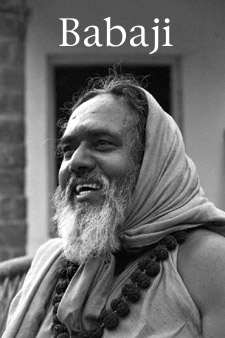 Tapasvi Babaji: He is one of the most respected Babas in the whole Udasin sect of renunciants. He practiced tapas (austerities) in the Himalayas from youth until the age of 30 or so, after which he came to the world to make an ashram and teach about spirituality. He is kind and grandfatherly, practically adopting me as a son and making certain I was comfortable whenever possible. When I am near him I always feel good, waves of bliss emanate from him, as does love. Later as he got to know me better he began complimenting me to such a great degree that I feel it egotistical and inappropriate to repeat what he said of me. Tapasvi Babaji: He is one of the most respected Babas in the whole Udasin sect of renunciants. He practiced tapas (austerities) in the Himalayas from youth until the age of 30 or so, after which he came to the world to make an ashram and teach about spirituality. He is kind and grandfatherly, practically adopting me as a son and making certain I was comfortable whenever possible. When I am near him I always feel good, waves of bliss emanate from him, as does love. Later as he got to know me better he began complimenting me to such a great degree that I feel it egotistical and inappropriate to repeat what he said of me.
Bhairav Muni-ji: (ji means respected, e.g. Baba-ji) Bhairav is Babaji's "son"-disciple who has been with him since Bhairav was a youth of 14 and Babaji was a hermit in the mountains. He has a Ph.D. and speaks fluent English, both accomplishments made after renouncing the world! He is a great friend of mine, and sincerely on the path of spirituality. However, he has not renounced many bad habits, like chewing tobacco and occasionally smoking marijuana, as well as having a few girlfriends from the USA and England with whom he practices Tantra. 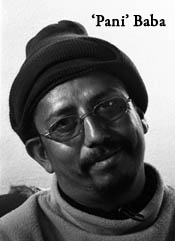
"Pani" Baba: The most kind and genuinely sweet sadhu I knew on this trip. I became quite close to him as we were roomates for 6 days. He spoke a little English, and I taught him much more while he helped me practice Hindi. His nickname "pani" means "water" because he drinks more than 4-5 liters a day. Har-Surif: (Pictured next to me in top photo) Babaji's disciple who was also trip navigator, photographer, and digital videographer. Very nice and sweet like a big teddy bear, but also can lose his temper and is quite "human". Our main interactions were me teaching him about cameras, and begging him to slow down our trip itinerary, or to stop at certain places. 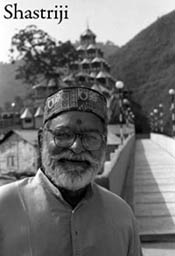
Shastri-Ji: An older man with a hearing aid who also adopted me as a son and gave me a beautiful white silk shirt to wear with the sadhus. He is in the process of renouncing his wife and pension to live out old age with Babaji and seek further spiritual development. He is already on the path, and told me the best thing about no hearing is that when you remove your hearing aid and close your eyes you are immediately in silence with god. 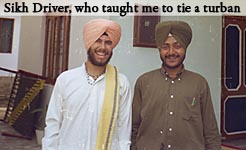 He was an English teacher and now quotes Thoreau, Shakespeare, and Emmerson, alongside Vedic Sanskrit aphorisms while discussing philosophy. He was an English teacher and now quotes Thoreau, Shakespeare, and Emmerson, alongside Vedic Sanskrit aphorisms while discussing philosophy.
Varanasi baba: (Pictured above) A dreadlocked, big-bellied, jovial Baba from Benares (Varanasi). He joined us in Delhi at Babaji and Bhairavji's invitation. Then there were two crazy drivers, one nice Sikh man and one young guy who antagonized me by nearly driving off cliffs. Our trip began after dinner at an ashram in Delhi. I was hoping to sleep before our journey, but I kearned quickly that Sadhus do not travel at an easy-going pace. We left at 10pm and drove all night until 10am when we arrived in a small, hot, town in the middle of 'nowhere', Himachal Pradesh.  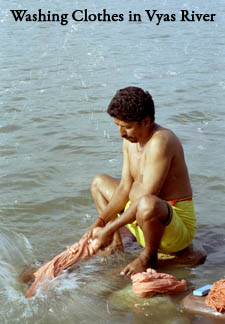 Our nightime journey included me not sleeping while crushed between two sadhus in the back seat of a car with loud music playing. We even had the joy of getting stuck on a road closed until a police checkpost re-opened, so we detoured on a dirt road. While driving in a dustcloud at pitch black 3am we found ourselves lost in a small Punjabi village with nearly no gas left. Imagine the villagers' surprise awaking to find 6 lost sadhus asking for directions!
When we finally arrived, Babaji seemed his usual self: unfazed, kind, truly happy, and content. The rest of us, however, showed signs of extreme weariness. I felt so wretched my journal entry for that day sounds like it was written by a cranky man on his deathbed. Nonetheless we were given rooms from the local village people and slept for 5 hours. That is how I became "Pani" Baba's roommate and discovered the disturbing fly infestation of the lower foothills.
Our nightime journey included me not sleeping while crushed between two sadhus in the back seat of a car with loud music playing. We even had the joy of getting stuck on a road closed until a police checkpost re-opened, so we detoured on a dirt road. While driving in a dustcloud at pitch black 3am we found ourselves lost in a small Punjabi village with nearly no gas left. Imagine the villagers' surprise awaking to find 6 lost sadhus asking for directions!
When we finally arrived, Babaji seemed his usual self: unfazed, kind, truly happy, and content. The rest of us, however, showed signs of extreme weariness. I felt so wretched my journal entry for that day sounds like it was written by a cranky man on his deathbed. Nonetheless we were given rooms from the local village people and slept for 5 hours. That is how I became "Pani" Baba's roommate and discovered the disturbing fly infestation of the lower foothills.
Although the town was situated on a cliffside above the beautiful Vyas River, our altitude was low and the heat bearable but wicked. Instead of leaving the next day, we got quagmired like a bad twilight zone episode, each day thinking the next was our last for 6 days. We settled into a routine at the town of eating lunch and dinner at a small local ashram and staying in the rooms provided for us nearby. It was because Babji was invited there that we came, but nobody knew he was scheduled to deliver a weeklong lecture series! 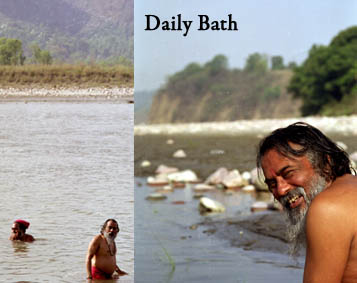 The Villagers had banners and a welcome parade, so in kindness and to avoid dishonor he spoke each day until we found a replacement sadhu to come from afar and replace him as a daily speaker. The Villagers had banners and a welcome parade, so in kindness and to avoid dishonor he spoke each day until we found a replacement sadhu to come from afar and replace him as a daily speaker.
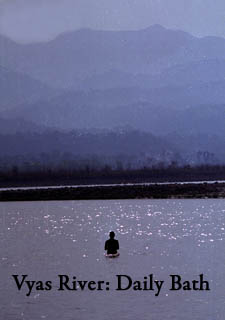 The good thing about staying there was the relaxing schedule, Babaji got up at 5am for a 10 kilometer walk, but some other sadhus and I slept until 8 or 9am when chai was served and we roused ourselves for bathtime. We climbed down the cliff on cobblestone steps and bathed everyday in the Vyas River. At the shore all the Babas shed their saffron-orange/red robes and in a G-string like underwear bathed in the cold river and did their laundry with soap and beating clothing on stones. I learned how to bathe in my underwear in a river and do laundry Indian style. This was quite a novel experience for one so used to modern conveniences, but it was pleasant and natural. After such a bath ones clean body, hair, and clothes slightly glitter from the fine mica silt dust in the water. This daily ritual refreshed us and allowed us to face the hot day at the ashram.
The good thing about staying there was the relaxing schedule, Babaji got up at 5am for a 10 kilometer walk, but some other sadhus and I slept until 8 or 9am when chai was served and we roused ourselves for bathtime. We climbed down the cliff on cobblestone steps and bathed everyday in the Vyas River. At the shore all the Babas shed their saffron-orange/red robes and in a G-string like underwear bathed in the cold river and did their laundry with soap and beating clothing on stones. I learned how to bathe in my underwear in a river and do laundry Indian style. This was quite a novel experience for one so used to modern conveniences, but it was pleasant and natural. After such a bath ones clean body, hair, and clothes slightly glitter from the fine mica silt dust in the water. This daily ritual refreshed us and allowed us to face the hot day at the ashram.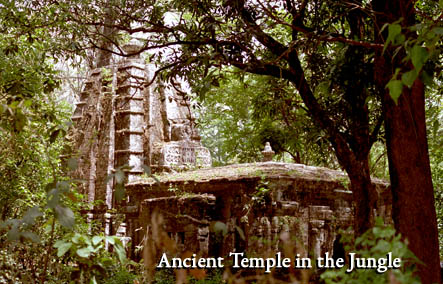
I quickly lost interest in the ashram activities and settled into my own pattern of relaxation after bathing: reading alternating with meditation and/or napping all day long. The above mentioned fly infestation and heat were the only conflicting factors. Flies were so prevalent that somehow every day they infested our room and I had to learn to nap with a thin scarf over my face after being constantly awakened with a disgusting crawling sensation on my eyes, nose, or lips - yuck! These flies apparently infest India in the beginning of summer until the bird, frog, and spider population catches up in breeding to control them. I practiced a meditation with flies crawling over my hands and arms. I tried to transcend the creepy tickly sensation - and sometimes succeeded, but more often I just had difficulty. I began to meditate in a 500-year-old temple I found while out walking one day. It was half grown over with green vines in the jungle and not used by the villagers. Although it had no door it was cooler than my room and had no flies inside! The place was perfect for meditation and nobody bothered me there. 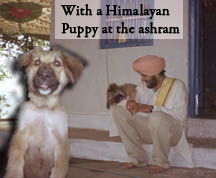 Every meal at the ashram consisted of Rice, Dal (cooked lentils), Sabzi (mixed vegetables), and Chapatis (like tortillas). This was served on a 'thali' - a large metal plate. We ate with our hands, scooping food into our mouths with chapatis or fingers. I liked the plain food most of the time, and if it weren't for the heat and flies and anticipation of leaving soon I would have liked the lifestyle. It is nice to bathe in nature and relax all day with meditation as a mainstay and the foreknowledge that all your sleeping and eating needs are provided for.
Every meal at the ashram consisted of Rice, Dal (cooked lentils), Sabzi (mixed vegetables), and Chapatis (like tortillas). This was served on a 'thali' - a large metal plate. We ate with our hands, scooping food into our mouths with chapatis or fingers. I liked the plain food most of the time, and if it weren't for the heat and flies and anticipation of leaving soon I would have liked the lifestyle. It is nice to bathe in nature and relax all day with meditation as a mainstay and the foreknowledge that all your sleeping and eating needs are provided for.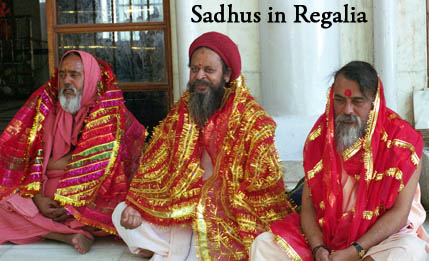
I bought a Turban and kind of learned how to tie it. Usually the Sikh driver helped me to put it on. On our last day in Jaisinghpur we drove to another village and visited the village matriarch's house for Bhajans (Prayer-songs) and lunch. She was a very sweet woman and when the Sadhus left I stayed behind with her. Instead of driving 40 minutes around the river valley, we walked back across the floodplain and paid a boatman to ferry us to the beach on the other side, below the ashram on a cliff. That night when we left, villagers touched my feet as if I too were a sadhu and offered me money. The other sadhus told me I could not refuse and to give them the offerings after the villagers left us This made me feel weird, I am not used to strangers touching my feet and respecting me like that. 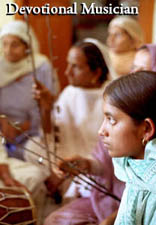
Finally we began moving and I was excited the first day, but soon let down. I was expecting cool air and snow-capped mountain vistas, but instead sometimes we traveled 12 hours a day in the warm, green Himalayan foothills regions. We basically visited a number of temples of historical/legendary significance, and in each we went to the temple inner sanctuary, skipping the line because of Babaji's presence, received the goddess's iconic darshan, and then left. I got a whirlwind tour of Himachal Pradesh - covering the original 12 day itinerary in 5-6 days, traveling over 1,000 kilometers with drivers moving at unsafe speeds on curvy cliffside roads. Nobody vomited but we all became sick, tired, and irritable. Babaji's car drove a little smoother, but in mine we all held seats and handles and received bumps on our heads from wall, window, and ceiling concussions. 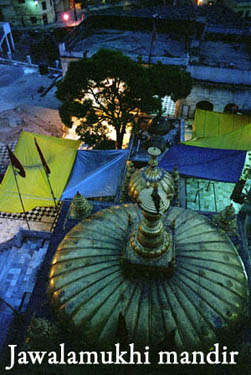
Nonetheless there are two places we visited that had special significance. The first day when I still had energy and was rested we went to Jawalamukhi Mandir - a 1500-year-old temple to the Goddess in her "jawal-mukhi", literally "flame-face", form. This mountain is filled with natural gas and the goddess is worshipped as a blue flame lit from a crack in the rock and surrounded by decorative silver and black soot. Pilgrims use the soot to mark a bindi 'dot' on their forehead after receiving the blessings of the flame. Above the temple is an Udasin sect ashram which also has Jawalamukhi in their ashram temple from a higher hole in the same mountain. We were invited as honored guests to their Aarti celebration. As you may know, Hindus perform a ceremony at sunrise and or sunset propitiating god in any form, like a river or idol, in this case a flame. The Aarti is done with music and singing and flames. As soon as they began blowing the horn Babaji, the sadhus, and I closed our eyes. I was immediately able to transcend to an inner awareness of bright light and pure happiness. Meanwhile I was simultaneously aware of the primal sounds of bells, cymbals, drums, and horns- resoundingly loud and voluminous. This filled my ears and the whole temple, vibrating the floor and maybe the heavens, too. This powerful experience was magnificent and made my day. 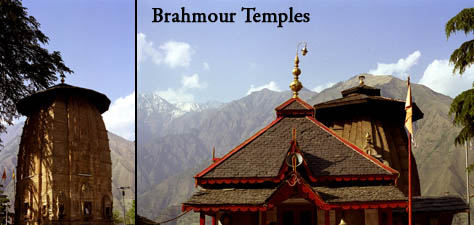
The rest of the trip we ate and slept in ashrams and covered many kilometers visiting temples to famous legendary conflicts between gods. I did see snow-capped Himalayas for two days in Chamba and Brahmour, where we visited an ancient hillside 1200-year-old stone temple compound that was magnificent. One temple was all wooden-carved and had a great feeling inside, but we did not have time to meditate there. I reiterate that our tempo did not agree with my idea of spiritual excursions. One interesting note about Indians and their enterprising ability: on the way to Brahmour the road was blocked by a landslide, and while we waited an hour for the bulldozer to clear it, the Indians in busses on either side climbed over the rubble with luggage on their heads and boarded another bus waiting on the other side of the blockage. They all arrived on a different bus than they began with - but this is how things work in India! 
In reality our journey was therefore more of an "introduction" to Himachal Pradesh - now I know where I would like to go again if I had time to visit more. We visited the beautiful Kullu valley as well, a famous location for Indian Honeymoons, and saw many touristy places along the way. That night when the ashram we were to stay at was too dirty and mosquito infested, I treated everyone to a hotel stay! For the low price of $25 US dollars I got 3 rooms for us to share, dinner for all, and common beds for the two drivers with the hotel staff. 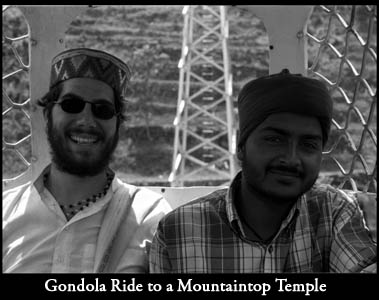 The last day we were to drive to an ashram near Delhi, but I left the group in Chandigarh, the capitol of Punjab. I was tired of traveling with the sadhus and had to book my rail reservations for the rest of my last week in India. Shastriji was very sad to see me go and made me promise to visit him next time I come to India. Babaji also seemed sad, asking me why I had to go. I explained that rather than go with them to their ashram for a week, I wanted to spend my last days in India in the Himalayas meditating and soaking in my whole experience.
The last day we were to drive to an ashram near Delhi, but I left the group in Chandigarh, the capitol of Punjab. I was tired of traveling with the sadhus and had to book my rail reservations for the rest of my last week in India. Shastriji was very sad to see me go and made me promise to visit him next time I come to India. Babaji also seemed sad, asking me why I had to go. I explained that rather than go with them to their ashram for a week, I wanted to spend my last days in India in the Himalayas meditating and soaking in my whole experience.
Although I had difficulty with the pace and destinations of our travel, it was a great experience. I learned that most sadhus are quite 'normal'. I was so fortunate to have the opportunity to encounter and spend time with a master of spirituality like Babaji who does not seem to have human frailties and personality flaws like all the others. If I could have spoken Hindi I think I would have had a better experience, but I still soaked up his energy and loved the experience. Next: My final week in India spent hiking and meditating in the high Himalayas... |